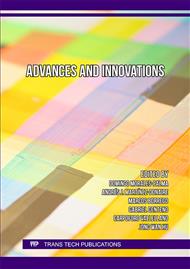[1]
Q. Liang, D. Zhang, W. Wu, and K. Zou, "Methods and research for multi-component cutting force sensing devices and approaches in machining" Sensors (Switzerland), vol. 16, no. 11. MDPI AG, p.1–17, Nov. 16, 2016.
DOI: 10.3390/s16111926
Google Scholar
[2]
M. Yang, J. Yang, L. Zhu, X. Yu, A novel curvature circle iterative algorithm for contour error control of multi-axis CNC machine tools Precis. Eng., 65 (2020), pp.23-31
DOI: 10.1016/j.precisioneng.2020.05.005
Google Scholar
[3]
B. Yang, G. Zhang, Y. Ran, H. Yu, Kinematic modeling and machining precision analysis of multi-axis CNC machine tools based on screw theory, Mech. Mach. Theory., 140 (2019), pp.538-552.
DOI: 10.1016/j.mechmachtheory.2019.06.021
Google Scholar
[4]
D. Zhu, X. Feng, X. Xu, Z. Yang, W. Li, S. Yan, H. Ding, Robotic grinding of complex components: a step towards efficient and intelligent machining – challenges, solutions, and applications, Robot. Cim-Int. Manuf., 65 (2020)
DOI: 10.1016/j.rcim.2019.101908
Google Scholar
[5]
R. P. Singh and S. Singhal, "Rotary Ultrasonic Machining: A Review" Mater. Manuf. Process., vol. 31, no. 14, p.1795–1824, 2016.
DOI: 10.1080/10426914.2016.1140188
Google Scholar
[6]
T. A. R. Ferreira, "Automatic volume inspection for glass blow moulds" Master degree in Product Design Engineering. Instituto Politecnico de Leiria, 2020.
Google Scholar
[7]
W. Höland and G. H. Beall, "Advanced Ceramics Machining," in Handbook of Advanced Ceramics: Materials, Applications, Processing, and Properties: Second Edition, Ioan D. Marinescu, Ed. 2013, p.371–381.
DOI: 10.1016/b978-0-12-385469-8.00021-6
Google Scholar
[8]
B.Y. Chen, E.Z. Zhang, L.P. Yan, et al., A laser interferometer for measuring straightness and its position based on heterodyne interferometry Rev Sci Instrum, 80 (11) (2009), Article 115113
DOI: 10.1063/1.3266966
Google Scholar
[9]
D.M. Lee, H.H. Lee, S.H. Yang, Analysis of squareness measurement using a laser interferometer system, Int J Precis Eng Man, 14 (2013), pp.1839-1846
DOI: 10.1007/s12541-013-0246-0
Google Scholar
[10]
D. Maruyama, S. Ibaraki, R. Sakata, Measurement of machine tool two-dimensional error motions using direction-regulated laser interferometers, Int J Auto Tech, 2 (2022), p.16
DOI: 10.20965/ijat.2022.p0157
Google Scholar



